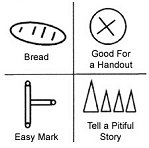

What are the lessons from the Bible's Tower of Babel story? Without shared language, human cooperation--and hence society itself--would be impossible. By sharing language, individuals are more likely to share a common world view. In terms of our lessons on perception and beliefs,, language makes for the possibility of living in an intersubjective world (the word "symbol" comes from the Greek symbola, meaning a contract). In fact, as Emile Durkheim argued, the prospect of individual thought is impossible to contemplate--it is almost an absurdity--since language and categorization arise together in social intercourse.
Memes are to anthropologists what genes are to biologists: carriers of life’s organizing principles. And as biologists worry about diminishing biodiversity so cultural scientists worry about the abatement of cultural diversity. According to SIL International (the publisher of Ethnologue: Languages of the World), hundreds of languages—the DNA of cultures, if you will--are dead or dying and thousands more are expected to become extinct over the 21st century. (see Native Languages of the Americas: Preserving and Promoting American Indian Languages and The Rosetta Project, the latter "building an archive of all documented human languages.")
 Cross-culturally, people's orientations to time, space, self
and other vary considerably because of the languages they speak. Cultures, in fact, vary in
their very assumption about the relationship between language and "reality": Words and
thoughts are believed by the Navaho to actually create reality, whereas Europeans believe
words and thoughts merely reflect an outside reality. Joseph Brodsky, exiled Soviet poet and
winner of the 1987 Nobel Prize in literature, observed of his art: "What provides you with
subject matter is your own language--and that's all. It sort of coils in your mind, that sort of
thing, and dictates something to you. A writer is a tool of the language rather than the other
way around."
Cross-culturally, people's orientations to time, space, self
and other vary considerably because of the languages they speak. Cultures, in fact, vary in
their very assumption about the relationship between language and "reality": Words and
thoughts are believed by the Navaho to actually create reality, whereas Europeans believe
words and thoughts merely reflect an outside reality. Joseph Brodsky, exiled Soviet poet and
winner of the 1987 Nobel Prize in literature, observed of his art: "What provides you with
subject matter is your own language--and that's all. It sort of coils in your mind, that sort of
thing, and dictates something to you. A writer is a tool of the language rather than the other
way around."
The key assumption of symbolic interactionists is that people act toward objects and others on the basis of their meanings. Meaning is symbolic and symbolic orders are fragile systems. Change the symbolic and one not only distorts but even destroys the meaning referent, as when one repeats a word over and over again. In addition, these meanings reside within the relations among things and the distinctions they make. Obliterate these distinctions, such as by making each holiday no different from any other (i.e., celebrate not on the dates memorialized but make 3-day commercialized weekends out of them all), and one loses meaning. Finally, according to those from the Durkheimian tradition, these perceived relations among things are ultimately determined by the relations among people.
In The Fine Line, Eviatar Zerubavel develops how language allows us to detach mental entities from their surroundings and to assign them fixed, decontextualized meanings. Such detachments, the deriving of categories of things, involves making discreteness out of continuums. The cultural variations in the process are impressive: "while there is a single word for both rats and mice in Latin, insects and airplanes in Hopi, and brothers-in-law and grandnephews in the Algonquian language of the Fox, there are separate words or blankets that are folded and spread out, for water in buckets and in lakes, and for dogs that stand and sit in Navajo" (p. 63). Among the consequences of such semantic parsings of the world are seeing greater similarities among elements within a category of things than may, in fact, be the case, and seeing greater differences between elements within different categories. Further, "we often commit the fallacy of misplaced concreteness and regard such purely mental constructs as if they were actually real" (p. 79). In sum, as C. Wright Mills observed, "By acquiring the categories of a language we acquire the structured `ways' of a group, and along with the language, the value-implicates of those `ways'" (p. 433 of "Language, Logic and Culture" in Power, Politics and People).
One lesson of "My Fair Lady" (which was from George Bernard Shaw's "Pygmalion") is how language functions as a code of membership. Different social groups emerge with different languages, which allow members to distinguish who is in their group and who is not. To distinguish themselves from "lesser others," English aristocrats spoke Norman French into the 15th century just as early 20th century educated Russians and Poles spoke French. Working class speech, according to the research of Basil Bernstein, Leonard Schatzman, and Anselm Strauss, is marked by its immediacy (most verbs are present tense: "What's happening?"), empathy and stress on collective emotion. Mountain climbers "sew up the route" instead of "cratering" or having a "screamer" like novices. The status of in- group members are linguistically reaffirmed while members of out-groups are often belittled, as when skiers refer to snowboards as "knuckle draggers."
 Power comes to those who know the language of a
particular group, and those "not in the know" often must defer to those who speak computerese, bureaucratese, or legalese. For an interesting read check out William Lutz's
Doublespeak: From "Revenue Enhancement" to "Terminal Living" How Government,
Business, Advertisers, and Others Use Language to Deceive You. He quotes GM's
Thomas Murphy, who claims that business is bad because "We are in a period of negative
economic growth" (p.106); the military's reference to shooting its own men as the "accidental
delivery of ordinance equipment" which creates "friendly casualties" (p.176). In the November
1990 issue of Executive Recruiter News, the following list of euphemisms for
"you're fired" was proffered: outplacement, downsizing, right-sizing, force reduction, infinite
idling, redundancy elimination, involuntary separation, skill-mix adjustment, and fumigation.
Feel better?
Power comes to those who know the language of a
particular group, and those "not in the know" often must defer to those who speak computerese, bureaucratese, or legalese. For an interesting read check out William Lutz's
Doublespeak: From "Revenue Enhancement" to "Terminal Living" How Government,
Business, Advertisers, and Others Use Language to Deceive You. He quotes GM's
Thomas Murphy, who claims that business is bad because "We are in a period of negative
economic growth" (p.106); the military's reference to shooting its own men as the "accidental
delivery of ordinance equipment" which creates "friendly casualties" (p.176). In the November
1990 issue of Executive Recruiter News, the following list of euphemisms for
"you're fired" was proffered: outplacement, downsizing, right-sizing, force reduction, infinite
idling, redundancy elimination, involuntary separation, skill-mix adjustment, and fumigation.
Feel better?
In 1952, when the first APA Diagnostic and Statistical Manual of Mental Disorders (DSM) appeared, there were 106 forms of psychiatric abnormalities listed. Forty-two years later, over 300 were listed, from "Major Depression" and "Schizophrenia" to such designations "Hypoactive Sexual Desire Disorder," "Disorder of Written Expression" (which involves poor grammar and bad spelling and handwriting), and "lexical anhedonia" (the inability to feel pleasure while reading). What are the implications of so labeling people?
Labels have a tendency to become self-fulling prophecies.
People tend to conform to the labels others apply to them, which is referred to as the Pygmalion
Effect. In writing of the works of Michel Foucault and Ian Hacking, Mary
Douglas writes in How Institutions Think:
As fast as new medical categories (hitherto unimagined) were invented, or new
criminal or sexual or moral categories, new kinds of people spontaneously came forward in
hordes to accept the labels and to live accordingly. The responsiveness to new labels suggests
extraordinary readiness to fall into new slots and to let selfhood be defined. ...[P]eople are not
merely re-labeled and newly made prominent, still behaving as they would behave whether so
labeled or not. The new people behave differently than they ever did before (p.100).

Consider the importance of prior information that you
have about individuals before first interacting with them. Would it not
be nice to know their social class and educational background, age, what
they do for a living, their religious faith and religiosity? In many ways
we do (or so we think)--if we know their names.
 And when individuals do
make such onomastic assumptions they can lead to self-fulfilling prophecies.
On the basis of a name the bearer's gender (with exception of the 1970s
unisex fad), generation (there are generational naming fashions: have you
noticed how many of the flowers--the Roses and Violets--now reside in nursing
homes?), ethnicity and race, region of birth (where else can the 60-year-old
Bubbas and Jimmys be from but the South?), and social class (Roman numerals
rarely follow the monikers of the poor) can often be inferred.
And when individuals do
make such onomastic assumptions they can lead to self-fulfilling prophecies.
On the basis of a name the bearer's gender (with exception of the 1970s
unisex fad), generation (there are generational naming fashions: have you
noticed how many of the flowers--the Roses and Violets--now reside in nursing
homes?), ethnicity and race, region of birth (where else can the 60-year-old
Bubbas and Jimmys be from but the South?), and social class (Roman numerals
rarely follow the monikers of the poor) can often be inferred.
Parents spend hours debating names for babies-believing, perhaps correctly, that to name something is to shape its destiny. The enterprise is not new. The Puritans believed that one's name was the vessel of the soul, and that character or behavior can be manipulated through use of names. Accordingly, recorded in English parish registers of the 16th and 17th centuries were such morally saturated appellations as Sindenie, Fear-not, Search-the-Scriptures, Prudence, Chastity, Charity, and Flie-Fornication. Whether these labels produced morally superior existences or some "Boy Named Sue" counterreactions is not known. However, observing how occupational fate can be bestowed by names, Ralph Slovenko ("On Naming," American Journal of Psychotherapy 34(2):208- 19) writes:
Consider that John Minor Wisdom, Pleas Jones, William Justice and Learned Hand are judges. Russell Brain is a brain surgeon, William Dance is a dancing instructor, William Key is a jail warden, Cardinal Sin is an archbishop, Groaner Digger is an undertaker, I.C. Shivers is an iceman, ... Mrs. Screech is a singing teacher, A. Moron is a commissioner of education, Lavender Sidebottom is a masseuse, Seymor Smelsey is a food doctor, Peter Atchoo is a pneumonia specialist, Law & Lynch are lawyers, Plummer & Leek are plumbers, Wyre & Tapping are detectives, ... (1980:208-9).
What if people had tails and, like dogs, can not help but wag them when excited or have them point straight down when shamed? Think about how social life would be changed. Who knows, perhaps the game of poker would become obsolete. Business dealings may well require that top executives and sales staff have their tails clipped lest they let on to customers and rivals what they really think. There are social scientists who believe that individuals do, despite their best attempts, emit such uncontrollable expressions of their true feelings and motivations. Paul Ekman, for example, has identified certain involuntary movements of facial muscles that accompany lying behavior, such as body movements and facial expressions being out of sync, asymmetrical facial expressions, and declining use of gestures. Prolonged smiles are usually false as authentic facial expressions generally fade within five seconds.
Despite our garrulousness, experts have estimated that perhaps as little as 20% of our communication occurs through verbal channels. Bill Bryson notes in The Mother Tongue: English & How It Got That Way (William Morrow, 1990:36-7):
A vital adjunct to language is the gesture, which in some cultures can almost constitute a vocabulary all its own. Modern Greek has more than seventy common gestures, ranging from the chopping off the forearm gesture, which signifies extreme displeasure, to several highly elaborate ones, such as placing the left hand on the knee, closing one eye, looking up with the other into the middle distance and wagging the free hand up and down, which means "I don't want anything to do with it." According to Mario Pei, the human anatomy is capable of producing some 700,000 "distinct elementary gestures" of this type.
 For an animated story of the alphabet's evolution,
click here.
For an animated story of the alphabet's evolution,
click here.
![]()